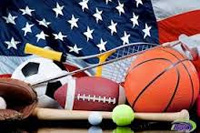 On your mark … Get set … Go!!! Leap into the action and excitement, the euphoria and heartbreak, the exercise and exhaustion of reading in motion with this week’s book review column on sports sponsored by the Children’s Literature and Reading SIG of IRA. Summer brings time for family activities, ball games, bike rides, swimming, and more. Schools bring on organized sports and team competitions, championship games or physical education classes to introduce all kinds of physical exercises and challenges. All of these opportunities provide stories that authors transform into reading in motion for the individual interested in staying active or the team spirit to go for the win. Win with reading!
On your mark … Get set … Go!!! Leap into the action and excitement, the euphoria and heartbreak, the exercise and exhaustion of reading in motion with this week’s book review column on sports sponsored by the Children’s Literature and Reading SIG of IRA. Summer brings time for family activities, ball games, bike rides, swimming, and more. Schools bring on organized sports and team competitions, championship games or physical education classes to introduce all kinds of physical exercises and challenges. All of these opportunities provide stories that authors transform into reading in motion for the individual interested in staying active or the team spirit to go for the win. Win with reading!
ReadWriteThink offers a host of ideas to build reading lesson plans around a sports theme that include sports poetry, using trading cards, sports trivia, star searches and many more ways to grab young readers’ interests.
Teachers might also be interested in the many reading activities that professional sports teams support to encourage reading in local schools. In the current issue of Reading Today (June/July 2013, p.24) the Fast Break Campaign is featured with the American Basketball Association. Other examples include: the Book Jackets program sponsored by the NHL Hockey team the Columbus Blue Jackets, or the NBA program called Read to Achieve. NFL Football players can be contacted to go into schools and read during Read Across America or other literacy events. Other examples include the High Achievers game tickets from the Cleveland Indians; the San Antonio Spurs and the “What’cha Reading Program; the Miami Dolphins summer library incentive program Most Valuable Reader, and many, many more programs that professional athletics support to promote reading with children and young people.
GRADES K-2
Coy, John. (2013) Hoop genius: how a desperate teacher and a rowdy gym class invented basketball. Illus. by Joe Morse. Minneapolis, MN: Carolrhoda/Lerner Books.
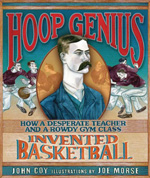 It started in 1891 in the state of Massachusetts when James Naismith was hired to take over a rowdy physical education class after the previous two teachers had resigned in frustration. Knowing he had to come up with a PE lesson that would keep these young and energetic boys moving, he created a spin-off from an old childhood game called Duck on a Rock. He used two peach baskets and an old soccer ball and devised ways for the boys to run back and forth and use skill and finesse to achieve a goal rather than the power of brawn and bulk previously displayed in their gym classes. Prior to this the roughhousing boys were constantly getting injured in their lacrosse and even other inside games. This “basket ball” caught on and the boys shared the game with their friends. Teachers from other schools heard about the new game and came to visit Naismith’s classes to learn more and how to play. The illustrations are done in blue and sepia tones to provide an atmosphere of the late nineteenth century and the endpapers sport the original thirteen rules of Basket Ball. Author end notes give even more history and detail of this new sport and explain how it became an Olympic sport in 1936. Find extra teacher resources at the publisher's website.
It started in 1891 in the state of Massachusetts when James Naismith was hired to take over a rowdy physical education class after the previous two teachers had resigned in frustration. Knowing he had to come up with a PE lesson that would keep these young and energetic boys moving, he created a spin-off from an old childhood game called Duck on a Rock. He used two peach baskets and an old soccer ball and devised ways for the boys to run back and forth and use skill and finesse to achieve a goal rather than the power of brawn and bulk previously displayed in their gym classes. Prior to this the roughhousing boys were constantly getting injured in their lacrosse and even other inside games. This “basket ball” caught on and the boys shared the game with their friends. Teachers from other schools heard about the new game and came to visit Naismith’s classes to learn more and how to play. The illustrations are done in blue and sepia tones to provide an atmosphere of the late nineteenth century and the endpapers sport the original thirteen rules of Basket Ball. Author end notes give even more history and detail of this new sport and explain how it became an Olympic sport in 1936. Find extra teacher resources at the publisher's website.
- Karen Hildebrand, Ohio Library and Reading Consultant
Jordan, Deloris. (2012). Dream big; Michael Jordan and the pursuit of Olympic gold. Illus. by Barry Root. New York: Simon and Schuster.
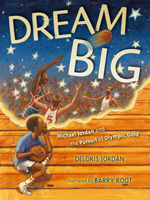 Basketball star Michael Jordan’s mother, Deloris, writes this story about her son’s dream of being in the Olympics from the time he was a small child. As he becomes thoroughly entrenched in basketball and watches the U.S. Olympic team play against Russia, he decides then that the Olympics will be his own personal goal. With advice from his coach and constant support and encouragement from his mother to practice, practice, practice in addition to studying and keeping his grades up, Michael sets out to meet this personal challenge. He gets the kind of incentive he needs to further his commitment when he attends one of his older brother’s scrimmages and makes a three-point shot. Root’s watercolor and gouache illustrations add to the excitement and movement of the game. Use this video moment of inspiration from Michael’s mother to extend discussion of the book or use this interview with Deloris Jordan.
Basketball star Michael Jordan’s mother, Deloris, writes this story about her son’s dream of being in the Olympics from the time he was a small child. As he becomes thoroughly entrenched in basketball and watches the U.S. Olympic team play against Russia, he decides then that the Olympics will be his own personal goal. With advice from his coach and constant support and encouragement from his mother to practice, practice, practice in addition to studying and keeping his grades up, Michael sets out to meet this personal challenge. He gets the kind of incentive he needs to further his commitment when he attends one of his older brother’s scrimmages and makes a three-point shot. Root’s watercolor and gouache illustrations add to the excitement and movement of the game. Use this video moment of inspiration from Michael’s mother to extend discussion of the book or use this interview with Deloris Jordan.
- Karen Hildebrand, Ohio Library and Reading Consultant
Joyner, Andrew. (2013). Boris for the win. New York, NY: Scholastic.
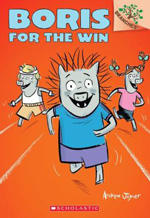 Every school has one—a talented athlete that no one ever seems able to beat. In the case of Boris and his two best friends, Alice and Frederick, the physically talented classmate is Eddie, who also happens to be a bit of a jerk. Despite repeated losses to Eddie, Boris wants to do well during the upcoming school field day. With Alice as their running coach, the two friends embark on a training program. All three of them get stronger, and when time for the meet arrives, Boris somehow runs faster than Eddie. But sometimes winning the race isn’t everything. Just as he nears the finish line and is ready to raise his arms in triumph, Boris realizes that Frederick, lagging far behind the rest of the field, is ready to quit. His resulting actions show that there is more than one way to define winning. It’s hard to resist this series with its warthog protagonist, funny illustrations, and positive messages about life choices.
Every school has one—a talented athlete that no one ever seems able to beat. In the case of Boris and his two best friends, Alice and Frederick, the physically talented classmate is Eddie, who also happens to be a bit of a jerk. Despite repeated losses to Eddie, Boris wants to do well during the upcoming school field day. With Alice as their running coach, the two friends embark on a training program. All three of them get stronger, and when time for the meet arrives, Boris somehow runs faster than Eddie. But sometimes winning the race isn’t everything. Just as he nears the finish line and is ready to raise his arms in triumph, Boris realizes that Frederick, lagging far behind the rest of the field, is ready to quit. His resulting actions show that there is more than one way to define winning. It’s hard to resist this series with its warthog protagonist, funny illustrations, and positive messages about life choices.
- Barbara A. Ward, Washington State University Pullman
Meshon, Aaron. (2013). Take me out to the Yakyu. New York: Atheneum Books for Young Readers.
 If you are a fan of major league baseball, you have noticed the popularity of baseball in Japan and the Japanese players that have come to the United States to play. The young narrator of this story is biracial and takes us to baseball games in the United States and in Japan, since he has a grandfather in each country that take him out to the ballgame! Energetic language and vivid colors portray the excitement of the game as well as the little boy’s enthusiasm. He shares with readers the differences and similarities in the game between the two cultures. Easting peanuts in the U.S. ballparks and soba noodles in Japanese ballparks, cheering with a big foam hand in the U.S. and a huge plastic horn in Japan, or singing “Take me out to the ball game” during the 7th inning stretch in the U.S. or singing the team’s anthem with a balloon release at the end show this same but different idea of the game. At the end of his fun filled day, he takes a bubble bath in the U.S. and a steam ofuro in Japan, both used to wash away the day’s excitement but leave a pleasurable memory. An author’s note at the end adds more details that also include a glossary of Japanese terms. Use this book trailer to introduce the book and enjoy an interview with author/illustrator Aaron Meshon.
If you are a fan of major league baseball, you have noticed the popularity of baseball in Japan and the Japanese players that have come to the United States to play. The young narrator of this story is biracial and takes us to baseball games in the United States and in Japan, since he has a grandfather in each country that take him out to the ballgame! Energetic language and vivid colors portray the excitement of the game as well as the little boy’s enthusiasm. He shares with readers the differences and similarities in the game between the two cultures. Easting peanuts in the U.S. ballparks and soba noodles in Japanese ballparks, cheering with a big foam hand in the U.S. and a huge plastic horn in Japan, or singing “Take me out to the ball game” during the 7th inning stretch in the U.S. or singing the team’s anthem with a balloon release at the end show this same but different idea of the game. At the end of his fun filled day, he takes a bubble bath in the U.S. and a steam ofuro in Japan, both used to wash away the day’s excitement but leave a pleasurable memory. An author’s note at the end adds more details that also include a glossary of Japanese terms. Use this book trailer to introduce the book and enjoy an interview with author/illustrator Aaron Meshon.
- Karen Hildebrand, Ohio Library and Reading Consultant
Morales, Yuyi. (2013). Niño wrestles the world. New York, NY: Roaring Brook Press: A Neal Porter Book.
 Intrigued by lucha libre, a colorful form of professional wrestling popular in Mexico, Niño is positively obsessed by the sport. In his fantasies he, too, is able to wrestle others to great acclaim. Wearing his underpants and a mask to disguise his identity, he has all the right moves to win. With clever strategies such as the Tickle Tackle, the Puzzle Muzzle, and the Doll Decoy, he motors through five fierce opponents—the Guanajuato Mummy, the Olmec Head, the Weeping Woman, El Chamuco, and even El Extraterrestre. But Niño faces his toughest challenge once his two sisters wake from their naps, and the relentless Las Hermanitas give him a run for his money. The brightly-hued illustrations have a comic book feel to them and are filled with the sounds of Nino's physical efforts and celebration until he encounters his sisters. The story and text are sure to prompt a smile or two and kindle interest in this sport. Readers may find it easy to relate to Nino’s sports fantasies.
Intrigued by lucha libre, a colorful form of professional wrestling popular in Mexico, Niño is positively obsessed by the sport. In his fantasies he, too, is able to wrestle others to great acclaim. Wearing his underpants and a mask to disguise his identity, he has all the right moves to win. With clever strategies such as the Tickle Tackle, the Puzzle Muzzle, and the Doll Decoy, he motors through five fierce opponents—the Guanajuato Mummy, the Olmec Head, the Weeping Woman, El Chamuco, and even El Extraterrestre. But Niño faces his toughest challenge once his two sisters wake from their naps, and the relentless Las Hermanitas give him a run for his money. The brightly-hued illustrations have a comic book feel to them and are filled with the sounds of Nino's physical efforts and celebration until he encounters his sisters. The story and text are sure to prompt a smile or two and kindle interest in this sport. Readers may find it easy to relate to Nino’s sports fantasies.
- Barbara A. Ward, Washington State University Pullman
Tavares, Matt. (2013). Becoming Babe Ruth. Somerville, MA: Candlewick Press.
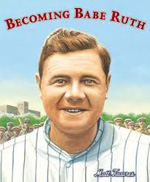 The incorrigible George Ruth spent most of his formative years in a Baltimore boys' school because his father was unable to rein in his son. There, the man who would become known as Babe Ruth as a mighty slugger for the New York Yankees learned to follow rules and fell in love with baseball. Readers may understand Ruth’s initial disdain for rules and school work, but also recognize that focusing on baseball under the tutelage of Brother Matthias eased his loneliness and offered him respite from St. Mary’s strict regimen. What's particularly intriguing about Babe's story is how he never forgot the school where he grew up or the hours Brother Matthias spent refining his baseball skills during his youth. When trouble comes to the school, Babe comes to the rescue. The text and watercolor, gouache, and pencil illustrations capture the humanity of this man from humble origins who became larger than life. The images that show him gleefully devouring ice cream alongside several boys from St. Mary’s typify his zest for life and generosity. Interestingly, the Author's Note reminds readers that Babe achieved fame through newspaper coverage of his feats since there was no television to feature highlights of his performances. There is much to enjoy about the book, including the autographed baseball on the title page, the news clippings that show Babe Ruth at bat, and even a table with his impressive pitching and batting statistics.
The incorrigible George Ruth spent most of his formative years in a Baltimore boys' school because his father was unable to rein in his son. There, the man who would become known as Babe Ruth as a mighty slugger for the New York Yankees learned to follow rules and fell in love with baseball. Readers may understand Ruth’s initial disdain for rules and school work, but also recognize that focusing on baseball under the tutelage of Brother Matthias eased his loneliness and offered him respite from St. Mary’s strict regimen. What's particularly intriguing about Babe's story is how he never forgot the school where he grew up or the hours Brother Matthias spent refining his baseball skills during his youth. When trouble comes to the school, Babe comes to the rescue. The text and watercolor, gouache, and pencil illustrations capture the humanity of this man from humble origins who became larger than life. The images that show him gleefully devouring ice cream alongside several boys from St. Mary’s typify his zest for life and generosity. Interestingly, the Author's Note reminds readers that Babe achieved fame through newspaper coverage of his feats since there was no television to feature highlights of his performances. There is much to enjoy about the book, including the autographed baseball on the title page, the news clippings that show Babe Ruth at bat, and even a table with his impressive pitching and batting statistics.
- Barbara A. Ward, Washington State University Pullman
Winter, Jonah. (2012, 2013). You never heard of Willie Mays? Illus. by Terry Widener. New York: Schwartz and Wade Books.
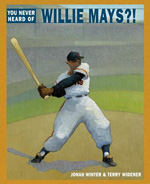 Following the successful, You Never Heard of Sandy Koufax? (2009), author Jonah Winter has returned with baseball great, Willie Mays. Willie, eventually known as The Say Hey Kid, grew up in Birmingham, Alabama, and was devoted to Joe DiMaggio and his style of playing the game of baseball. As a young man, Willie started in the Negro Leagues, but in 1951 started his new career with the New York Giants, knocking out a home-run pitched by baseball Hall-of-Famer, Warren Spahn, and from that moment Willie’s career skyrocketed. Willie Mays could do it all when it came to baseball—hit, throw, pitch, run, home runs, stolen bases—and his statistics topped all the charts. Rivaling Babe Ruth’s reputation as the greatest baseball player of all time, this glimpse at the career of Willis Mays through the eyes of a child and devoted fan, will give readers a feel for one of baseball’s greatest players. Sidebars throughout the book give tidbits of baseball history, facts and statistics that add to the informational value of the book. As with the Koufax book, children will love the lenticular cover. Enjoy this book trailer about this new book. Also read about him on the Engage blog.
Following the successful, You Never Heard of Sandy Koufax? (2009), author Jonah Winter has returned with baseball great, Willie Mays. Willie, eventually known as The Say Hey Kid, grew up in Birmingham, Alabama, and was devoted to Joe DiMaggio and his style of playing the game of baseball. As a young man, Willie started in the Negro Leagues, but in 1951 started his new career with the New York Giants, knocking out a home-run pitched by baseball Hall-of-Famer, Warren Spahn, and from that moment Willie’s career skyrocketed. Willie Mays could do it all when it came to baseball—hit, throw, pitch, run, home runs, stolen bases—and his statistics topped all the charts. Rivaling Babe Ruth’s reputation as the greatest baseball player of all time, this glimpse at the career of Willis Mays through the eyes of a child and devoted fan, will give readers a feel for one of baseball’s greatest players. Sidebars throughout the book give tidbits of baseball history, facts and statistics that add to the informational value of the book. As with the Koufax book, children will love the lenticular cover. Enjoy this book trailer about this new book. Also read about him on the Engage blog.
- Karen Hildebrand, Ohio Library and Reading Consultant
GRADES 3-5
Abdul-Jabbar, Kareem. (2013). Sasquatch in the paint. New York: Disney-Hyperion.
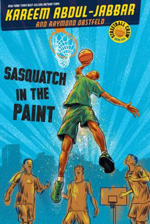 Beginning a new series from Disney-Hyperion called Streetball Jammers, Book One, basketball legend Kareem Abdul-Jabbar launches the series that is loosely based on some of his early life experiences. Theo Rollins is the main character that enters his eighth grade year six inches taller than he was last year and is quickly dubbed Sasquatch. The basketball coach immediately recruits Theo for the team though Theo, self-proclaimed nerd, knows absolutely nothing about basketball and is still trying to coordinate his newly acquired growth spurt. In addition, he now struggles with balancing practices and games against his science club preparation for the Aca-lympics that are looming on the horizon. When Rain, a new girl from California, moves in and is tagged as the Crazy Girl, Theo forms a friendship with her. They both stand out and are different in their own ways. She is Muslim and Theo is one of the few black kids in school. This story is about relationships and dealing with differences as much as it is about basketball. Kids will enjoy listening and watching Jabbar talk about his book in this video interview.
Beginning a new series from Disney-Hyperion called Streetball Jammers, Book One, basketball legend Kareem Abdul-Jabbar launches the series that is loosely based on some of his early life experiences. Theo Rollins is the main character that enters his eighth grade year six inches taller than he was last year and is quickly dubbed Sasquatch. The basketball coach immediately recruits Theo for the team though Theo, self-proclaimed nerd, knows absolutely nothing about basketball and is still trying to coordinate his newly acquired growth spurt. In addition, he now struggles with balancing practices and games against his science club preparation for the Aca-lympics that are looming on the horizon. When Rain, a new girl from California, moves in and is tagged as the Crazy Girl, Theo forms a friendship with her. They both stand out and are different in their own ways. She is Muslim and Theo is one of the few black kids in school. This story is about relationships and dealing with differences as much as it is about basketball. Kids will enjoy listening and watching Jabbar talk about his book in this video interview.
- Karen Hildebrand, Ohio Library and Reading Consultant
Birmingham, Maria. (2013). Weird zone: sports: the strangest, funniest, and most daringest events from the world of athletics and beyond! Toronto, ON: Owlkids Books, Inc.
 Most of the books reviewed this week are about more traditional sports like baseball, basketball, football and others. Weird Zone takes readers into the world of sports that are not often in the limelight or as the subtitle announces—the strangest, funniest and most daring events. Photographs, sidebars, fact boxes, diagrams, quizzes, and a variety of typography and fonts bring readers sports like zorbing (rolling down a hill in a large inflatable ball), joggling (juggling while jogging), quidditch (HP fans will know!), or yukigassen (Japanese snowball fighting) just to name a few. Extra informative pieces include facts on necessary equipment, the science behind the sport, rules and record breakers and much more. Each two-page spread introduces a new concept in these zany sports or daring activities that will make it difficult for readers to stop reading unless they want to jump up and try some of these fun-filled athletic amusements.
Most of the books reviewed this week are about more traditional sports like baseball, basketball, football and others. Weird Zone takes readers into the world of sports that are not often in the limelight or as the subtitle announces—the strangest, funniest and most daring events. Photographs, sidebars, fact boxes, diagrams, quizzes, and a variety of typography and fonts bring readers sports like zorbing (rolling down a hill in a large inflatable ball), joggling (juggling while jogging), quidditch (HP fans will know!), or yukigassen (Japanese snowball fighting) just to name a few. Extra informative pieces include facts on necessary equipment, the science behind the sport, rules and record breakers and much more. Each two-page spread introduces a new concept in these zany sports or daring activities that will make it difficult for readers to stop reading unless they want to jump up and try some of these fun-filled athletic amusements.
- Karen Hildebrand, Ohio Library and Reading Consultant
Bowen, Fred. (2013). Perfect game. Atlanta, GA: Peachtree Publishers.
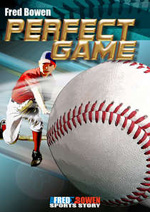 Author Fred Bowen started to write this book ten years ago but just didn’t like the way it was going. He let the story simmer and this past year attended some of the Special Olympics Unified Sports practices and games. He got to know the players and their families and in so doing, the story settled in. Thirteen-year-old Isaac Burnett is the main character and star pitcher of his baseball team. He is also a perfectionist and his goal is to pitch the perfect game with no hits, no runs, and no walks. He comes frustratingly close and mentally beats himself up that he just missed his goal for that perfect game. His coach is sensing Isaac’s frustration and tension within himself and suggests that Isaac help with the United Sports basketball team in their area. This is a team comprised of intellectually challenged kids in addition to mainstream kids, all playing together on the same team against other teams composed of the same mix of players. Isaac gets a whole new concept of what “perfect” really is and the value, or not, of competitive play and the pressure it puts on players … and perfectionist young pitchers. The author writes “The Score” which is a weekly column in the Kids Post section of The Washington Post newspaper. Read the backstory at the author’s website.
Author Fred Bowen started to write this book ten years ago but just didn’t like the way it was going. He let the story simmer and this past year attended some of the Special Olympics Unified Sports practices and games. He got to know the players and their families and in so doing, the story settled in. Thirteen-year-old Isaac Burnett is the main character and star pitcher of his baseball team. He is also a perfectionist and his goal is to pitch the perfect game with no hits, no runs, and no walks. He comes frustratingly close and mentally beats himself up that he just missed his goal for that perfect game. His coach is sensing Isaac’s frustration and tension within himself and suggests that Isaac help with the United Sports basketball team in their area. This is a team comprised of intellectually challenged kids in addition to mainstream kids, all playing together on the same team against other teams composed of the same mix of players. Isaac gets a whole new concept of what “perfect” really is and the value, or not, of competitive play and the pressure it puts on players … and perfectionist young pitchers. The author writes “The Score” which is a weekly column in the Kids Post section of The Washington Post newspaper. Read the backstory at the author’s website.
- Karen Hildebrand, Ohio Library and Reading Consultant
Flood, Nancy Bo. (2013). Cowboy up! Ride the Navajo rodeo. Illus. by Jan Sonnemair. Honesdale, PA: Boyds Mills Press/Wordsong.
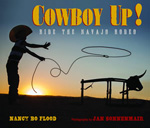 Juxtaposing informative text, commentary from a rodeo announcer, and 18 poems from different voices, this book provides insight into Navajo rodeos, weekly events that draw competitors from all over the country. Not only do these competitions provide entertainment, unite families and provide a place to socialize and enjoy good food, but they also offer ways for youngsters to test their nerves and strength. In “Midway Walk,” a young competitor imagines how he will be “Wearing my new boots / steel-toed, stay-in-the-stirrup boots” (p. 22) while Bodacious, “the orneriest, deadliest, / twisting, spinning, kicking, leaping / bull / ever” (p. 3) is described in “Big, Bad Bulls.” The book contains vignettes and large photographs featuring sheep, horses, and bulls, all as part of the rodeo, as well as fast-paced barrel racing. The back matter provides additional information about the history of rodeos, but all of this leaves readers curious to know even more about these events so common in the West.
Juxtaposing informative text, commentary from a rodeo announcer, and 18 poems from different voices, this book provides insight into Navajo rodeos, weekly events that draw competitors from all over the country. Not only do these competitions provide entertainment, unite families and provide a place to socialize and enjoy good food, but they also offer ways for youngsters to test their nerves and strength. In “Midway Walk,” a young competitor imagines how he will be “Wearing my new boots / steel-toed, stay-in-the-stirrup boots” (p. 22) while Bodacious, “the orneriest, deadliest, / twisting, spinning, kicking, leaping / bull / ever” (p. 3) is described in “Big, Bad Bulls.” The book contains vignettes and large photographs featuring sheep, horses, and bulls, all as part of the rodeo, as well as fast-paced barrel racing. The back matter provides additional information about the history of rodeos, but all of this leaves readers curious to know even more about these events so common in the West.
- Barbara A. Ward, Washington State University Pullman
Hyde, Natalie. (2013). Hockey girl. Markham, ON: Fitzhenry & Whiteside.
 Softball season is over, and Tara and Rachel feel really good about winning the semifinal game. By way of a challenge from the boys’ hockey team that the girls should play a real sport, Tara and Rachel are goaded into joining the girls’ hockey team thinking it will be a great way to stay in shape and train for next year’s softball season. The challenge demand that whoever end up lowest in the rankings at the end of the season has to be the cheerleaders for the following season. The girls’ team soon learns how little respect they get and not only from the boys but other members of their hockey-crazy Canadian community of Cartwright who make fun of the girls and heap insults on their efforts. When a tournament pops up on the schedule that kicks the girls out of their rink time or drop the team altogether, they are threatened with losing their competitive standing against the boys’ team. Humorously written, the girls take a stand and fight for their right to play. Download the teacher’s guide at the author’s website.
Softball season is over, and Tara and Rachel feel really good about winning the semifinal game. By way of a challenge from the boys’ hockey team that the girls should play a real sport, Tara and Rachel are goaded into joining the girls’ hockey team thinking it will be a great way to stay in shape and train for next year’s softball season. The challenge demand that whoever end up lowest in the rankings at the end of the season has to be the cheerleaders for the following season. The girls’ team soon learns how little respect they get and not only from the boys but other members of their hockey-crazy Canadian community of Cartwright who make fun of the girls and heap insults on their efforts. When a tournament pops up on the schedule that kicks the girls out of their rink time or drop the team altogether, they are threatened with losing their competitive standing against the boys’ team. Humorously written, the girls take a stand and fight for their right to play. Download the teacher’s guide at the author’s website.
- Karen Hildebrand, Ohio Library and Reading Consultant
Maddox, Jake. (2012). Horseback hurdles. Text by Emma Carlson Berne. Illus. by Katie Wood. Mankato, MN: Stone Arch/ Capstone Books.

Written with reluctant or emerging readers in mind, the Jake Maddox series offers easy to read stories. Mia has been a volunteer at the Rocky Ridge Riding Center for three months and she makes more than her share of mistakes including leaving grain out for the mice got into it, or leaving the saddles out in the rain. As the book opens, two horses, Trixie and Diamond, have escaped after Mia forgot to close the pasture gate … again! Mia and Sky go after the horses with Mia offering to retrieve Diamond, who has the nastier disposition. Maren, the head instructor at the center has had enough of Mia’s careless ways and so calls her into the office to send her packing. Mia despondently leaves Maren’s office and on her way out overhears a conversation that Diamond is going to be sold away because he is a biter. Mia races back into the office and offers a deal to Maren. If she can stay she will work with Diamond to get him to stop biting and turn him into a horse worthy of saving for the center. Maren agrees to give Mia until the Rocky Ridge Rumpus just four days away. Now Mia has to figure out how to stop Diamond from biting and being such a dangerous horse. She brings carrots and apples, she combs and grooms him, she learns to move slowly around him so as not to startle or scare him. Though the Rumpus did not go as smoothly as Mia had hoped, horse and rider learned to trust each other.
- Karen Hildebrand, Ohio Library and Reading Consultant
Wacholtz, Anthony. (2014). Picture a home run; a baseball drawing book. (Drawing with Sports Illustrated Kids). Illus. by Erwin Haya. Minneapolis, MN: Capstone Press.
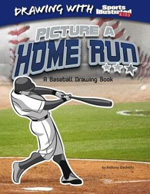 Kids love drawing books, so throw in the sports theme and you have a winner! Starting with advice on needed supplies, the author/ illustrator team give step-by-step instructions on how to draw various aspects of the game of baseball. Diagrams include a hitter, bunting, a home run, squaring up to bunt, digging in for third base, stealing bases, staying in front of the base in a crouch, making the throw, stretching for the out, the play at home plate, robbing homers, the windup and many more baseball scenarios. Other drawing books in this series include: Slam Dunk; Slap Shot; and Touchdown.
Kids love drawing books, so throw in the sports theme and you have a winner! Starting with advice on needed supplies, the author/ illustrator team give step-by-step instructions on how to draw various aspects of the game of baseball. Diagrams include a hitter, bunting, a home run, squaring up to bunt, digging in for third base, stealing bases, staying in front of the base in a crouch, making the throw, stretching for the out, the play at home plate, robbing homers, the windup and many more baseball scenarios. Other drawing books in this series include: Slam Dunk; Slap Shot; and Touchdown.
- Karen Hildebrand, Ohio Library and Reading Consultant
Wise, Bill. (2013). Silent star; the story of deaf major leaguer William Hoy. Illus. by Adam Gustavson. New York: Lee and Low Books.
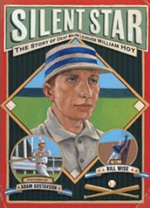 Born in Houktown, Ohio, William Ellsworth Hoy (1862-1961) contracted meningitis when he was three years old, and it left the young child in deafness and isolation. Tagged with the nickname Dummy, the name stuck through his whole life; Hoy even referred to himself as Dummy. This was a term often used with deaf people. He graduated from the Ohio School for the Deaf and excelled in baseball. He was discovered by a minor league coach and started to play for a team in Oshkosh, Wisconsin, where people associated with the organization of baseball doubted that a deaf man could succeed in this career. But Bill Hoy proved them wrong. Using his eyes and with keen observation, he set records and statistics that still stand today. The opening scene in the book is the crowd going wild throwing confetti and hats to visually cheer Dummy Hoy for an outstanding play he made during a game while he could not hear their cheers. Some baseball fans credit William Hoy for starting the signals system used by catchers to the pitcher and that is in use today and can be seen during any major league game. Hoy went on to play for the Washington Nationals in 1888, the New York Giants, and the Cincinnati Reds where he is in the Reds Hall of Fame. His skill and dedication to the game are beautifully illustrated and witnessed through the pictures of Adam Gustavson’s detailed oil paintings that depict the handlebar mustaches, vintage uniforms, and a glimpse of ballparks of yesteryear. Read more about baseball, writing and this author at the publisher’s website or learn more about William Hoy at the American Sign Language website or the Cincinnati Reds Hall of Fame website.
Born in Houktown, Ohio, William Ellsworth Hoy (1862-1961) contracted meningitis when he was three years old, and it left the young child in deafness and isolation. Tagged with the nickname Dummy, the name stuck through his whole life; Hoy even referred to himself as Dummy. This was a term often used with deaf people. He graduated from the Ohio School for the Deaf and excelled in baseball. He was discovered by a minor league coach and started to play for a team in Oshkosh, Wisconsin, where people associated with the organization of baseball doubted that a deaf man could succeed in this career. But Bill Hoy proved them wrong. Using his eyes and with keen observation, he set records and statistics that still stand today. The opening scene in the book is the crowd going wild throwing confetti and hats to visually cheer Dummy Hoy for an outstanding play he made during a game while he could not hear their cheers. Some baseball fans credit William Hoy for starting the signals system used by catchers to the pitcher and that is in use today and can be seen during any major league game. Hoy went on to play for the Washington Nationals in 1888, the New York Giants, and the Cincinnati Reds where he is in the Reds Hall of Fame. His skill and dedication to the game are beautifully illustrated and witnessed through the pictures of Adam Gustavson’s detailed oil paintings that depict the handlebar mustaches, vintage uniforms, and a glimpse of ballparks of yesteryear. Read more about baseball, writing and this author at the publisher’s website or learn more about William Hoy at the American Sign Language website or the Cincinnati Reds Hall of Fame website.
- Karen Hildebrand, Ohio Library and Reading Consultant
Wissinger, Tamera Will. (2013). Gone fishing: A novel. Illus. by Matthew Cordell. New York, NY: Houghton Mifflin Books for Children.
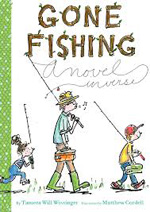 Dipping into as many different poetic techniques and forms as some fishing fanatics have lures, the author pays tribute to the time-honored family fishing tribute. Containing haiku, limerick, list poems, an ode, and even a triolet, this delightful novel in verse will bring smiles to readers' faces since the scenes will be familiar to many from their own experiences. Nine-year-old Sam eagerly anticipates the fishing trip he and his father have planned. But his enthusiasm is considerably dampened when Lucy, his younger sister, joins them. To add insult to injury, she turns out to be great at fishing. The poems capture the day's high points (catching fish) and low points (not getting a nibble) effectively, even describing the delicious fresh-caught meal enjoyed at the end of the day. The pen and ink and watercolor illustrations show the family dynamics perfectly while affording readers glimpses of the majestic scenery through which father, son, and daughter travel to reach their fishing spot. The author has provided information on poetry at the end of the book in the form of a Poet's Tackle Box. Teachers will want to use this title as bait to hook their own students on the possibilities of poetry.
Dipping into as many different poetic techniques and forms as some fishing fanatics have lures, the author pays tribute to the time-honored family fishing tribute. Containing haiku, limerick, list poems, an ode, and even a triolet, this delightful novel in verse will bring smiles to readers' faces since the scenes will be familiar to many from their own experiences. Nine-year-old Sam eagerly anticipates the fishing trip he and his father have planned. But his enthusiasm is considerably dampened when Lucy, his younger sister, joins them. To add insult to injury, she turns out to be great at fishing. The poems capture the day's high points (catching fish) and low points (not getting a nibble) effectively, even describing the delicious fresh-caught meal enjoyed at the end of the day. The pen and ink and watercolor illustrations show the family dynamics perfectly while affording readers glimpses of the majestic scenery through which father, son, and daughter travel to reach their fishing spot. The author has provided information on poetry at the end of the book in the form of a Poet's Tackle Box. Teachers will want to use this title as bait to hook their own students on the possibilities of poetry.
- Barbara A. Ward, Washington State University Pullman
GRADES 6-8
Green, Tim. (2013). Force out. New York, NY: HarperCollins.
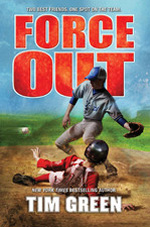 Joey and Zach always greeted each other affectionately as “Bro” since they are best friends share a love for baseball and a desire for a spot on the all-star baseball team. Joey is determined not to let Zach miss the play-offs due to some field trip Mr. Kratz, the mean teacher, had planned on the same day. The boys decide to tamper with Mr. Kratz's car and poison his dog to cancel the trip. Since Joey’s team loses the spot to play in the championships, they can send only one person to the championship game. Would it be Butch, Tom, or Zack? Joey is torn between admitting to the crime and giving up his position. But that is not easy since he has always dreamed of playing in the all-star championship and later, playing baseball for Stanford. To complicate matters, Joey's mom, the deputy sheriff, is investigating the crime and keeps asking Joey for updates and information about his friends. Additionally, Joey can’t tell his mother the truth because Leah, the prettiest girl in the school, is interested in him. Somehow, the rivalry between Zach and Joey accelerates, and the friends begin to drift apart. The easy-going, ever smiling boys soon become cautious and suspicious around each other. Told in short, swift chapters, the story is filled with suspense and builds readers’ anticipation well. The author is familiar with the game of baseball and uses that knowledge to create the suspense and tension that propels the story forward. The interactions between parents and children are presented realistically. Baseball fans will enjoy this title.
Joey and Zach always greeted each other affectionately as “Bro” since they are best friends share a love for baseball and a desire for a spot on the all-star baseball team. Joey is determined not to let Zach miss the play-offs due to some field trip Mr. Kratz, the mean teacher, had planned on the same day. The boys decide to tamper with Mr. Kratz's car and poison his dog to cancel the trip. Since Joey’s team loses the spot to play in the championships, they can send only one person to the championship game. Would it be Butch, Tom, or Zack? Joey is torn between admitting to the crime and giving up his position. But that is not easy since he has always dreamed of playing in the all-star championship and later, playing baseball for Stanford. To complicate matters, Joey's mom, the deputy sheriff, is investigating the crime and keeps asking Joey for updates and information about his friends. Additionally, Joey can’t tell his mother the truth because Leah, the prettiest girl in the school, is interested in him. Somehow, the rivalry between Zach and Joey accelerates, and the friends begin to drift apart. The easy-going, ever smiling boys soon become cautious and suspicious around each other. Told in short, swift chapters, the story is filled with suspense and builds readers’ anticipation well. The author is familiar with the game of baseball and uses that knowledge to create the suspense and tension that propels the story forward. The interactions between parents and children are presented realistically. Baseball fans will enjoy this title.
- Rani Iyer, Washington State University Pullman
Lupica, Mike. (2013). Game changers: play makers. New York: Scholastic Press.
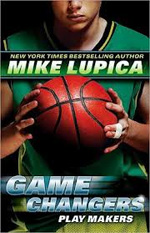 In the second book in the Game Changer series from sports journalist Mike Lupica, sixth-grade Ben McBain is still on a high from the touchdown pass that won their championship football game. Now basketball season is near and Ben is ready to throw himself and his friends into practicing for the new season. However, a new kid named Chase Braggs has moved in and might be a challenge for Ben as the star player. Chase has some slick moves on the court and Ben sees that he will have to hustle to keep his status on the team. However, it perhaps an overzealous and brash move, his friend Sam is hurt while Ben is trying to prove himself and Ben has to question what is best for the team. Use this video where Mike discusses sportsmanship on the Today Show.
In the second book in the Game Changer series from sports journalist Mike Lupica, sixth-grade Ben McBain is still on a high from the touchdown pass that won their championship football game. Now basketball season is near and Ben is ready to throw himself and his friends into practicing for the new season. However, a new kid named Chase Braggs has moved in and might be a challenge for Ben as the star player. Chase has some slick moves on the court and Ben sees that he will have to hustle to keep his status on the team. However, it perhaps an overzealous and brash move, his friend Sam is hurt while Ben is trying to prove himself and Ben has to question what is best for the team. Use this video where Mike discusses sportsmanship on the Today Show.
- Karen Hildebrand, Ohio Library and Reading Consultant
GRADES 9-12
Fichera, Liz. (2013). Hooked. Buffalo, NY: Harlequin Teen.
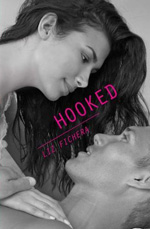 Sixteen-year old Fredricka (Fred) Oday, a Native American and living on the Gila River Indian Reservation in Arizona, is an outstanding golfer. The Lone Butte High School golf coach learns of her talent and recruits her for the high school varsity team. However, in doing this he has to cut Seth, another high school golfer, off the team. Ryan Berenger is the high school hottie, Seth’s best friend, and now Fredricka’s golf partner. Their relationship on the team begins as animosity with Ryan’s resentment of having his best friend kicked off the team and now having to play with someone from the “Rez,” let alone a girl, so the high school golf season is not looking good. Racial slurs and prejudicial treatment abound in this book. At the same time, Fred starts to see a side of Ryan that is actually very nice when he lets down his white rich boy guard. The two young golfers’ strained relationship starts to shift and the two young people begin to take a romantic interest in each other. Their love interest in each other endures many touches of bigotry and prejudice and could be compared to a contemporary Romeo and Juliet thematic setting. Nominated for a YALSA 2014 Best YA Fiction. Use this book trailer from Harlequin Teen TV to share with students or use this newspaper interview with the author for students to learn about a journalist’s approach to this debut YA author.
Sixteen-year old Fredricka (Fred) Oday, a Native American and living on the Gila River Indian Reservation in Arizona, is an outstanding golfer. The Lone Butte High School golf coach learns of her talent and recruits her for the high school varsity team. However, in doing this he has to cut Seth, another high school golfer, off the team. Ryan Berenger is the high school hottie, Seth’s best friend, and now Fredricka’s golf partner. Their relationship on the team begins as animosity with Ryan’s resentment of having his best friend kicked off the team and now having to play with someone from the “Rez,” let alone a girl, so the high school golf season is not looking good. Racial slurs and prejudicial treatment abound in this book. At the same time, Fred starts to see a side of Ryan that is actually very nice when he lets down his white rich boy guard. The two young golfers’ strained relationship starts to shift and the two young people begin to take a romantic interest in each other. Their love interest in each other endures many touches of bigotry and prejudice and could be compared to a contemporary Romeo and Juliet thematic setting. Nominated for a YALSA 2014 Best YA Fiction. Use this book trailer from Harlequin Teen TV to share with students or use this newspaper interview with the author for students to learn about a journalist’s approach to this debut YA author.
- Karen Hildebrand, Ohio Library and Reading Consultant
Higgins, M.G. (2013). Offside. Minneapolis, MN: Darby Creek/Lerner Books.
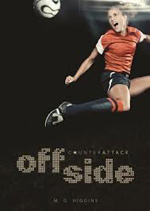 Faith Patel is a junior at Fraser High School, and playing soccer has become a refuge for Faith. A few years earlier her father died and left her family not only in emotional distress but also dealing with the financial strain. Her mother is a nurse often working late night shifts which requires Faith to babysit for her three younger siblings. Though soccer is her refuge, she finds herself on a team with girls that can afford to play in expensive club leagues and have developed skills that Faith can’t afford. When Coach Berg suggests Faith switch to a new soccer position and offers to spend extra time with her to make this transition, she develops a crush on the coach. Faith’s so-called friend Caitlyn is jealous of this extra attention from the coach and when she discovers Faith’s crush on the man, she begins to make life miserable for Faith. The two girls confront each other to face the situation giving readers an inside look at jealousy and misconstrued notions. Download the teacher’s guide to use with this book and the entire Counter series.
Faith Patel is a junior at Fraser High School, and playing soccer has become a refuge for Faith. A few years earlier her father died and left her family not only in emotional distress but also dealing with the financial strain. Her mother is a nurse often working late night shifts which requires Faith to babysit for her three younger siblings. Though soccer is her refuge, she finds herself on a team with girls that can afford to play in expensive club leagues and have developed skills that Faith can’t afford. When Coach Berg suggests Faith switch to a new soccer position and offers to spend extra time with her to make this transition, she develops a crush on the coach. Faith’s so-called friend Caitlyn is jealous of this extra attention from the coach and when she discovers Faith’s crush on the man, she begins to make life miserable for Faith. The two girls confront each other to face the situation giving readers an inside look at jealousy and misconstrued notions. Download the teacher’s guide to use with this book and the entire Counter series.
- Karen Hildebrand, Ohio Library and Reading Consultant
McClafferty, Carla Killough. (2013). Fourth down and inches. Minneapolis, MN: Carolrhoda/Lerner Books.
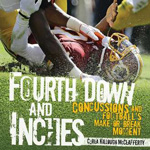 Carla McClafferty has delved into the history of football injuries and written an engaging and informative look at the results of traumatic head injuries in particular as a result of this rough sport. Football was almost banned when a student football player at the University of Georgia died in 1897 as a result of an injury. America has become so entrenched in this contact sport enthusiasts have refused to give up on the sport and consequently better equipment and training and attention to head injuries have been put in place to better safeguard young athletes. McClafferty interviewed not only researchers but also former athletes who have been affected by head injuries. Her book concludes a bibliography for further reading, extensive backmatter, and a list of ways to detect symptoms of concussion to determine if players should return to the game or how long they need to rest. Visit the author’s website for more background on this book and other nonfiction resources.
Carla McClafferty has delved into the history of football injuries and written an engaging and informative look at the results of traumatic head injuries in particular as a result of this rough sport. Football was almost banned when a student football player at the University of Georgia died in 1897 as a result of an injury. America has become so entrenched in this contact sport enthusiasts have refused to give up on the sport and consequently better equipment and training and attention to head injuries have been put in place to better safeguard young athletes. McClafferty interviewed not only researchers but also former athletes who have been affected by head injuries. Her book concludes a bibliography for further reading, extensive backmatter, and a list of ways to detect symptoms of concussion to determine if players should return to the game or how long they need to rest. Visit the author’s website for more background on this book and other nonfiction resources.
Karen Hildebrand, Ohio Library and Reading Consultant
Shen, Prudence. (2013). Nothing can possibly go wrong. Illus. by Faith Erin Hicks. New York, NY: First Second.
 Although they seem to have little in common, Nate Harding, president of the robotics club, and Charlie Nolan, captain of the basketball team, are friends. After all, Nate gets wound up about almost anything, and Charlie is too cool for words. Everyone gravitates to the easy-going Charlie while Nate has only a handful of folks that even know his name. But when the funding for Nate's robotics club is jeopardized by the cheerleading squad's need for new competition uniforms, he decides to run for Student Council president. The school principal has decided to let the Student Council decide how to spend the student activity funds. The cheerleaders don’t intend to take Nate’s campaign lying down, and they force Charlie to run against Nate. Charlie may be a good athlete, but he’s no match for the ferocity of these Amazonian cheerleaders when they want something, and he can’t say no to them. Furious, Nate even buys space on a display after Charlie’s basketball team loses a heartbreaker. As more mud gets slung, dirty tricks are played, and images are destroyed, the principal pulls the plug on funding for both groups. The robotics group cobbles together a desperate plan leading to an alliance with the cheerleaders and a road trip to a competition in Atlanta. This graphic novel is a treat, filled with insight into the various alliances that form in high school as well as the way adversity causes unlikely bonding. The panels are filled with detail and sly exchanges between some of the characters as they come to realize that both groups have quite a lot in common. Even while the two different groups are learning to work together, Charlie is fielding phone calls from his parents and working up the courage to speak his mind about family dynamics. Readers will anticipate even more from this insightful author and illustrator team.
Although they seem to have little in common, Nate Harding, president of the robotics club, and Charlie Nolan, captain of the basketball team, are friends. After all, Nate gets wound up about almost anything, and Charlie is too cool for words. Everyone gravitates to the easy-going Charlie while Nate has only a handful of folks that even know his name. But when the funding for Nate's robotics club is jeopardized by the cheerleading squad's need for new competition uniforms, he decides to run for Student Council president. The school principal has decided to let the Student Council decide how to spend the student activity funds. The cheerleaders don’t intend to take Nate’s campaign lying down, and they force Charlie to run against Nate. Charlie may be a good athlete, but he’s no match for the ferocity of these Amazonian cheerleaders when they want something, and he can’t say no to them. Furious, Nate even buys space on a display after Charlie’s basketball team loses a heartbreaker. As more mud gets slung, dirty tricks are played, and images are destroyed, the principal pulls the plug on funding for both groups. The robotics group cobbles together a desperate plan leading to an alliance with the cheerleaders and a road trip to a competition in Atlanta. This graphic novel is a treat, filled with insight into the various alliances that form in high school as well as the way adversity causes unlikely bonding. The panels are filled with detail and sly exchanges between some of the characters as they come to realize that both groups have quite a lot in common. Even while the two different groups are learning to work together, Charlie is fielding phone calls from his parents and working up the courage to speak his mind about family dynamics. Readers will anticipate even more from this insightful author and illustrator team.
- Barbara A. Ward, Washington State University Pullman
Skilton, Sarah. (2013). Bruised. New York: Amulet/Abrams Books.
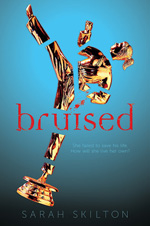 High school junior Imogen is a black belt in Tae Kwan Do, and yet she froze during a recent robbery that took place in the diner where she was eating. She hid under the table while a friend in the restroom dialed 911. When the police arrived they shot the gunman/robber, splattering blood all over Imogen. Imogen admonished herself over and over for just freezing, for doing nothing. She was not able to use her martial arts skills to disarm the would-be assailant and perhaps save her life. In that moment hiding under the table her eyes lock onto Ricky, a new student, also hiding under a table. In the weeks that follow the incident, she and Ricky become friends and this blossoms into a bit of romance. Prior to the violent incident, Imogen thought of her black belt as a powerful tool and it gave her a confidence that made her feel she could take on the world. However, when she does nothing during the robbery, she begins to question many of the things surrounding her life, from her girl-chasing brother Hunter to her diabetic and wheel-chair bound father to facing the looks she gets at school and at her dojang as she deals with the survivor guilt she carries. Debut author Sarah Skilton brings an exciting and thought-provoking story to contemporary YA fiction. Download a discussion guide and more information about marital arts at the author’s website.
High school junior Imogen is a black belt in Tae Kwan Do, and yet she froze during a recent robbery that took place in the diner where she was eating. She hid under the table while a friend in the restroom dialed 911. When the police arrived they shot the gunman/robber, splattering blood all over Imogen. Imogen admonished herself over and over for just freezing, for doing nothing. She was not able to use her martial arts skills to disarm the would-be assailant and perhaps save her life. In that moment hiding under the table her eyes lock onto Ricky, a new student, also hiding under a table. In the weeks that follow the incident, she and Ricky become friends and this blossoms into a bit of romance. Prior to the violent incident, Imogen thought of her black belt as a powerful tool and it gave her a confidence that made her feel she could take on the world. However, when she does nothing during the robbery, she begins to question many of the things surrounding her life, from her girl-chasing brother Hunter to her diabetic and wheel-chair bound father to facing the looks she gets at school and at her dojang as she deals with the survivor guilt she carries. Debut author Sarah Skilton brings an exciting and thought-provoking story to contemporary YA fiction. Download a discussion guide and more information about marital arts at the author’s website.
- Karen Hildebrand, Ohio Library and Reading Consultant
These reviews are submitted by members of the International Reading Association's Children's Literature and Reading Special Interest Group (CL/R SIG) and are published weekly on Reading Today Online. The International Reading Association partners with the National Council of Teachers of English and Verizon Thinkfinity to produce ReadWriteThink.org, a website devoted to providing literacy instruction and interactive resources for grades K–12.